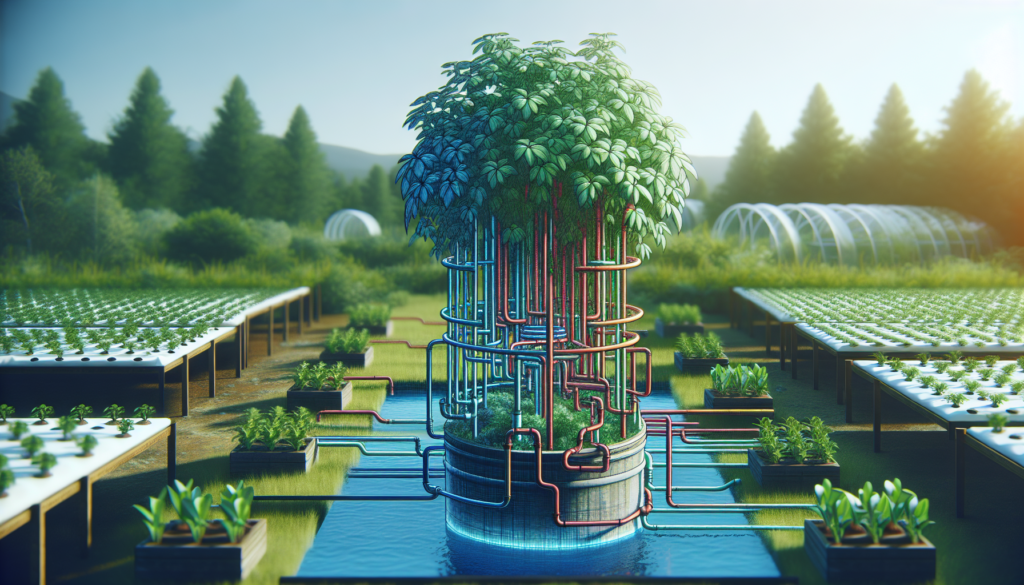Have you ever wondered what sets hydroponic fertilizer apart from regular fertilizer? Both play a crucial role in providing plants with the necessary nutrients for growth, but there are some distinct differences between the two. Hydroponic fertilizer is specifically formulated for plants grown in water-based systems without soil, while regular fertilizer is designed for traditional soil-based gardening. Join us as we explore the disparities between these two types of fertilizers and discover which is best suited for your gardening needs.
The Basics of Fertilizer
Definition of fertilizer
Fertilizer is a substance or mixture added to the soil or plants to provide essential nutrients that are necessary for healthy plant growth. This includes elements such as nitrogen, phosphorus, and potassium, as well as trace elements like iron, zinc, and copper.
Role of fertilizer in plant growth
Fertilizers play a crucial role in plant growth by supplying the necessary nutrients that are often deficient in the soil. These nutrients are essential for various biochemical processes within plants, including photosynthesis, root development, and overall cell growth. Fertilizers ensure that plants have a balanced supply of nutrients, which helps in improving yield, enhancing resistance to pests and diseases, and promoting overall plant health.
Different types of fertilizers
There are different types of fertilizers available in the market, categorized based on their nutrient composition and mode of application. The two main categories are organic and synthetic fertilizers. Organic fertilizers are derived from natural sources such as compost, manure, and plant residues, while synthetic fertilizers are chemically synthesized in a laboratory. Additionally, fertilizers can be classified as granular, liquid, or slow-release, depending on their physical form and nutrient release properties. Each type of fertilizer has its own advantages and considerations, depending on the specific requirements of the plants and the soil conditions.
Understanding Hydroponics
Definition of hydroponics
Hydroponics is a method of growing plants without soil, instead using a nutrient-rich water solution to provide the necessary mineral nutrients directly to the plant roots. In this system, plants are typically grown in an inert medium such as perlite, rockwool, or coconut coir, which acts as a medium for root support.
Advantages of hydroponics
Hydroponics offers several advantages over traditional soil-based growing methods. Firstly, it allows for more efficient use of water as the nutrient solution is recirculated, reducing water wastage. Secondly, hydroponics provides greater control over nutrient delivery, allowing for precise and optimized feeding of plants. This results in faster growth, higher yields, and improved quality of crops. Additionally, hydroponics eliminates the risk of soil-borne diseases and pests, reduces the need for pesticides, and enables year-round cultivation in controlled environments.
Importance of nutrient solutions in hydroponics
In hydroponics, nutrient solutions are crucial for providing plants with all the necessary macronutrients and micronutrients. These solutions are carefully formulated to ensure the right balance and concentration of nutrients that the plants require. Nutrient solutions in hydroponics are commonly composed of mineral salts, including compounds such as calcium nitrate, potassium nitrate, and magnesium sulfate. It is vital to monitor and adjust the nutrient solution regularly to maintain optimal plant growth and prevent nutrient deficiencies or toxicities.

Hydroponic Fertilizer: An Introduction
Definition of hydroponic fertilizer
Hydroponic fertilizer, also known as hydroponic nutrient solution, is specifically formulated for use in hydroponic systems. It is designed to provide plants with all the necessary nutrients in the absence of natural soil. Hydroponic fertilizers are usually in liquid form, making them easy to dissolve and deliver to the plants through the watering system.
Key components of hydroponic fertilizer
Hydroponic fertilizers consist of macro- and micronutrients that are essential for plant growth. The primary macronutrients present in hydroponic fertilizers are nitrogen (N), phosphorus (P), and potassium (K), commonly known as NPK. Additionally, secondary macronutrients like calcium (Ca), magnesium (Mg), and sulfur (S) are also included. Micronutrients such as iron (Fe), manganese (Mn), copper (Cu), zinc (Zn), boron (B), and molybdenum (Mo) are present in smaller quantities but are equally important for healthy plant development.
Benefits of using hydroponic fertilizer
Using hydroponic fertilizers in hydroponic systems offers several benefits. Firstly, these fertilizers are specifically designed to meet the nutrient requirements of plants grown in soilless environments, ensuring optimal growth and development. Secondly, nutrient absorption in hydroponics is more efficient compared to traditional soil systems, as plants have direct access to nutrients and can take them up rapidly. Additionally, hydroponic fertilizers are readily soluble and can be easily adjusted to meet specific crop needs. This flexibility allows growers to customize nutrient solutions and optimize plant performance.
Regular Fertilizer: An Overview
Definition of regular fertilizer
Regular fertilizer, also known as traditional or conventional fertilizer, is commonly used in soil-based gardening systems. It is formulated to provide plants with essential nutrients needed for growth and development, similar to hydroponic fertilizers. Regular fertilizers come in different forms, including granular, powdered, or pelletized.
Common types of regular fertilizer
There are various types of regular fertilizers available, each with a different nutrient composition. The most common types include balanced fertilizers, which contain equal amounts of nitrogen (N), phosphorus (P), and potassium (K). Other types include nitrogen-heavy fertilizers, phosphorus-rich fertilizers for flowering and fruiting plants, and potassium-focused fertilizers for promoting root growth. Regular fertilizers also come in organic forms, derived from natural sources, or synthetic forms that are chemically formulated.
Pros and cons of regular fertilizer
Regular fertilizers have their own advantages and disadvantages. One of the major advantages is their wide availability and relatively lower cost compared to specialized hydroponic fertilizers. Regular fertilizers also contribute to soil fertility and can improve the long-term nutrient content of the soil. However, they may have slower nutrient release rates, and some nutrients can leach into groundwater, potentially causing pollution. Moreover, regular fertilizers are not as precise in nutrient delivery as hydroponic fertilizers, as plants in soil-based systems may not efficiently absorb all the applied nutrients.

Nutrient Content
Differences in nutrient composition
The nutrient composition of hydroponic and regular fertilizers can vary significantly. While both types contain essential macro- and micronutrients, hydroponic fertilizers are formulated with a specific focus on meeting the nutritional needs of plants grown in soilless systems. Hydroponic fertilizers often have a more balanced nutrient profile, emphasizing the proper ratios of nitrogen, phosphorus, and potassium for optimal growth. In contrast, regular fertilizers come in various formulations, each tailored to the specific needs of different plants and growth stages.
Essential nutrients for plant growth
Plants require a range of essential nutrients for healthy growth and development. These nutrients can be broadly categorized as macronutrients and micronutrients. Macronutrients, required in relatively larger quantities, include nitrogen, phosphorus, potassium, calcium, magnesium, and sulfur. Micronutrients, required in smaller quantities, include iron, manganese, copper, zinc, boron, and molybdenum. Plants need all these nutrients in varying amounts to carry out vital physiological processes, and deficiencies in any of these nutrients can lead to stunted growth, reduced yields, or nutrient-specific disorders.
Availability of nutrients in hydroponic and regular fertilizers
Hydroponic fertilizers are designed for precise nutrient delivery, ensuring that all the necessary nutrients are readily available to the plants. The nutrient solutions in hydroponics are carefully calibrated to provide optimal concentrations of each nutrient, preventing deficiencies or excesses. On the other hand, regular fertilizers rely on the soil’s natural nutrient availability and the plant’s capacity to absorb nutrients. They may not offer the same level of control as hydroponic fertilizers, as nutrient availability can be influenced by soil pH, microbial activity, and the presence of natural organic matter.
Application Methods
Traditional soil-based application
In traditional soil-based gardening, fertilizers are typically applied by spreading them evenly over the soil surface surrounding the plants. This can be done by hand or using appropriate tools like a fertilizer spreader. The fertilizers are then incorporated into the soil by gently working them into the top few inches, ensuring they come into contact with the plant roots.
Methods of applying hydroponic fertilizer
Hydroponic fertilizers are applied in different ways, depending on the specific hydroponic system being used. In a nutrient film technique (NFT) system, the fertilizer is usually mixed with the recirculating water, allowing the plants’ roots to continuously absorb the nutrients as the solution flows over them. Other methods include the use of drip irrigation or misting systems, where the fertilizer is added to the water supply or directly sprayed onto the roots.
Frequency of application
The frequency of fertilizer application varies depending on the plants’ nutrient requirements, growth stage, and environmental conditions. In soil-based gardening, fertilizers are typically applied a few times during the growing season, with specific timings depending on the plant’s nutrient demands. In hydroponic systems, the nutrient solution is continuously circulated, ensuring a constant supply of nutrients to the plants. However, the concentration and composition of the nutrient solution may need to be adjusted periodically to account for nutrient uptake and plant growth.

Nutrient Uptake Efficiency
How nutrients are absorbed by plants
Plants absorb nutrients through their roots, which are equipped with root hairs that increase the surface area available for nutrient uptake. Nutrients can be taken up by plants in two ways: through active uptake, where the plant expends energy to transport ions against a concentration gradient, and through passive uptake, which relies on diffusion. Additionally, some plants have symbiotic relationships with beneficial soil organisms like mycorrhizal fungi, which enhance nutrient uptake by facilitating nutrient exchange between the soil and plant roots.
Factors affecting nutrient uptake efficiency
Several factors can influence the efficiency of nutrient uptake by plants. These include soil pH, nutrient concentration, temperature, humidity, and the presence of other elements in the soil. The pH of the soil or nutrient solution affects nutrient availability, as certain nutrients may become more or less soluble at different pH levels. Temperature and humidity influence the activity of plant roots and the rate of nutrient absorption. Finally, the presence of other elements, both beneficial and antagonistic, can interact with nutrient uptake and affect the overall nutrient uptake efficiency.
Comparison of nutrient absorption in hydroponic and regular systems
Overall, hydroponic systems tend to exhibit higher nutrient uptake efficiency compared to soil-based systems. In hydroponics, plants have direct access to the nutrient solution, allowing for rapid and efficient nutrient absorption. The absence of soil also eliminates potential nutrient losses due to leaching or fixation. Regular soil-based systems, on the other hand, can experience nutrient losses through leaching or microbial immobilization, which may reduce the overall nutrient uptake efficiency.
pH and EC Levels
Importance of pH and EC levels in plant nutrition
pH and electrical conductivity (EC) levels are essential factors in plant nutrition and nutrient availability. pH refers to the acidity or alkalinity of the soil or nutrient solution. pH levels influence nutrient availability as certain nutrients are more accessible to plants within specific pH ranges. EC, measured as the ability of a solution to conduct electricity, is an indicator of the solution’s nutrient concentration. The EC level provides valuable information about the nutrient status, allowing growers to adjust the nutrient solution accordingly.
Monitoring and adjusting pH and EC levels in hydroponics
In hydroponics, maintaining proper pH and EC levels is crucial for optimal plant growth. pH levels need to be carefully monitored and adjusted within the recommended range for the specific plant being cultivated. This is typically done by adding pH-adjusting agents such as pH up (base) or pH down (acid) solutions. Similarly, EC levels need to be regularly checked using a portable meter and adjusted by adding or diluting the nutrient solution to reach the desired concentration.
pH and EC levels in regular fertilizer
pH and EC levels are also relevant in regular fertilizer applications, although they are not as precisely controlled as in hydroponics. The pH of the soil can influence the availability of nutrients to plants, as some nutrients may become less accessible at extreme pH values. Similarly, the EC level in the soil can indicate the overall nutrient concentration but is not typically measured or adjusted directly in regular fertilizer application. Instead, regular fertilizer tends to rely on the soil’s natural buffering capacity and the plant’s ability to absorb nutrients over time.
Environmental Impact
Environmental concerns associated with hydroponic fertilizer
Hydroponic fertilizers can have both positive and negative environmental impacts. On the positive side, hydroponics offers more efficient use of water compared to traditional soil-based cultivation, reducing water consumption and preventing unnecessary wastage. Additionally, hydroponics reduces the need for soil and minimizes soil erosion, protecting valuable land resources. However, hydroponic systems require energy-intensive infrastructure and often rely on the production of synthetic fertilizers, which can have negative environmental consequences, including greenhouse gas emissions and the potential for nutrient runoff.
Impact of regular fertilizer on soil and water systems
Regular fertilizers used in traditional gardening can have significant impacts on soil and water systems. These fertilizers often contain high concentrations of nutrients, and if applied improperly, excess nutrients can leach into groundwater or runoff into nearby water bodies, leading to eutrophication and water pollution. Regular fertilizer use can also contribute to soil degradation and nutrient imbalances, as continuous applications may deplete beneficial soil microorganisms and disrupt natural nutrient cycling.
Sustainability considerations
Both hydroponic and regular fertilizer practices can be made more sustainable through careful management and mitigation strategies. This includes utilizing organic or slow-release fertilizers, adopting best management practices to minimize nutrient losses, and optimizing fertilizer application rates to match plant needs. Additionally, reducing the reliance on synthetic fertilizers and exploring natural alternatives can contribute to more sustainable agriculture practices.
Cost Analysis
Cost comparison of hydroponic and regular fertilizers
The cost of hydroponic and regular fertilizers can vary depending on several factors, including the brand, nutrient composition, and quantity required. In general, hydroponic fertilizers tend to be more expensive than regular fertilizers due to their specialized formulations and the need for precise nutrient delivery. Regular fertilizers are more widely available and often cost less, especially when purchased in large quantities.
Factors influencing overall cost
The overall cost of fertilizers also depends on various other factors, such as the size of the growing operation, crop type, and the specific nutrient requirements. Hydroponic systems may require additional equipment and infrastructure investments, such as nutrient dosing systems or automated monitoring systems, which can contribute to the overall cost. Additionally, regular fertilizer application may incur costs related to soil testing, as it is essential to monitor soil nutrient levels periodically to determine appropriate fertilizer application rates.
Long-term cost benefits
While hydroponic fertilizers may have a higher upfront cost, they can offer long-term cost benefits through increased crop yields and efficiency in nutrient delivery. The precise control over nutrient availability in hydroponic systems allows for optimized plant growth and reduced nutrient wastage. This efficiency can lead to higher crop yields, minimizing the need for excessive fertilization and potentially reducing overall fertilizer costs in the long run.
In conclusion, understanding the basics of fertilizer and the differences between hydroponic and regular fertilizers is essential for successful plant growth. Fertilizers play a vital role in supplying the necessary nutrients for plant development and ensuring optimal yield and crop quality. Hydroponics offers a soilless alternative that provides precise control over nutrient delivery, resulting in faster growth, higher yields, and year-round cultivation. However, both hydroponic and regular fertilizers have their advantages and considerations, and the choice depends on individual growing conditions, crop requirements, and environmental concerns. By carefully considering the specific nutrient needs, application methods, and environmental impact, growers can make informed decisions to promote sustainable and efficient plant growth.





